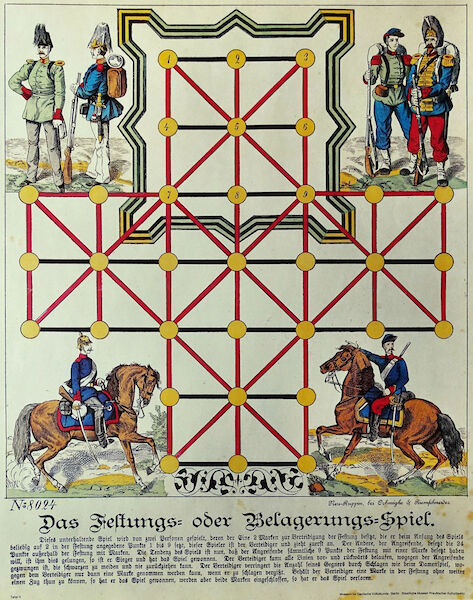Assault
Last updated: .
Assault is a traditional board game for two players that used to be popular throughout Europe. In English it is also commonly known by the Spanish name Asalto.
Assault was probably derived from the game of Fox & Geese, with which it shares a board. The play of the game is similar, but the object in Assault is for one side to achieve a particular arrangement of their pieces — although it is still possible to win by “trapping” like in Fox & Geese.

Reprint of an old German Assault board. Black lines indicate paths that the Attacker may not use.
2021 Stephan Krug, 🅮

A 19th century print; bold lines indicate paths the Attacker may not use.
In other languages and countries it is known as:
English: also known as “siege”, “citadel”,B or “(The New Military Game of) German Tactics” (published by John Jaques & Son)
German: das festungs-spiel or belagerungs-spiel ‘fortress game’ or ‘siege game’.A (p. 152)
Norwegian: beleiringsspill ‘siege game’
Swedish: belägringsspel ‘siege game’, or fästningsspel ‘fortress game’.A (p. 147)
The presentation of the game usually has a militaristic theme, often celebrating some recent engagement.
Setup

The board for Assault. The fortress is marked in red.
© George Pollard, 🅭🅯🄏🄎
The game is played on a board with 33 points arranged in a cross shape. Nine points on one arm of the cross are marked off to form the fortress.

The initial setup for Assault. The attacker’s pieces are purple and the defender’s are yellow.
© George Pollard, 🅭🅯🄏🄎
The two players are called the attacker and the defender.
The attacking player starts with twenty-four pieces, which are placed on each intersection outside the fortress. The defender starts with two pieces, which either begin the game on the points indicated in the diagram, or may be placed upon any points within the fortress (this differs by ruleset).
Play
The attacker starts and may move any of their pieces from its location to another empty location along one of the lines. The attacker’s pieces must always be moved towards the fortress, and in particular may never be moved sideways except at the very top of the two horizontal arms (these forbidden moves are the dashed lines in the diagram above; in printed sets the forbidden lines are often in a different colour).
The defender’s pieces move in a similar way, but are not required to move in any particular direction. They may also jump over an attacker’s piece in a straight line to a vacant point beyond it, as in checkers. This captures the jumped piece and removes it from the board. A defending piece may make multiple jumps in a single turn, and may change direction after each jump. The defender must make a jump if it is possible, and cannot jump one of their own pieces.

A defending piece may make multiple consecutive jumps.
© George Pollard, 🅭🅯🄏🄎
The goal of the attacker is to occupy every point of the fortress, or to surround their defender’s pieces so that they cannot move. The goal of the defender is to reduce the attacker to eight pieces so that they cannot achieve their goal. The first player to achieve their goal wins.
Variants
Alternate Boards
Many small variations of the board have been published. Some are displayed here. For these I do not have rules, so it is unclear if horizontal movements were permitted or not.

A board without most diagonals (as found here).
© George Pollard, 🅭🅯🄏🄎

A board variant for Fuchs und Henne, played with 20 attackers which are set up on all the lower points.
© George Pollard, 🅭🅯🄏🄎

A board variant for 2 Contra 20 (published by A. Eggenweiler), played with 20 attackers which are set up on all the lower points.
© George Pollard, 🅭🅯🄏🄎
Royal Garrison
The game has also been played with a larger board. In Germany this variant was called Grosses Festungs-Spiel (‘large fortress game’). In the United States the game was patented in 1915 by one Helmuth Dueberg.C Milton Bradley later published this game under the name “Three Guardsmen”, and later as “Bataan: The Battle of the Philippines” (1943) and “Three Musketeers” (1950). In Canada it was published as “Yellow Peril” by Somerville board games.D (p. 20) In England it was called “Royal Garrison” (published by John Jaques & Son),E (p. 274) “Siege” (J. W. Spear & Sons), or “Hungarian Tactics” (Ogilvy). It has also been published as “Fortification” and “Transvaal”.F
The defender has three pieces which start on the middle and either end of the bottom row of the fortress. The attacker has fifty pieces which are placed on all points outside the fortress. Play is otherwise the same as Assault.

© George Pollard, 🅭🅯🄏🄎
Another version of the “Royal Garrison” board connected all diagonals:

A different Royal Garrison board.
© George Pollard, 🅭🅯🄏🄎
See also
Fox & Geese is also played on the same board.
References
Fiske, Willard (). Chess in Iceland and in Icelandic literature, with historical notes on other table-games. The Florentine Typographical Society: Florence.
Bayerisches Spiele-Archiv (). ‘Medito: Box Front’ [archived]. On the website BoardGameGeek (accessed ).
Dueberg, Helmuth F. C. (). ‘Amusement Device’. Patent US1131603A. Filed Monday, 6th July 1914. Issued Tuesday, 9th March 1915.
Lewis, Norah Lillian (ed.) (). Freedom to Play: We Made Our Own Fun. Wilfrid Laurier University Press: Waterloo, Ontario, Canada. ISBN: 0-88920-406-3.
Dalton, Henry (). The Book of Drawing-Room Plays and Evening Amusements. James Hogg & Sons: London, England, UK.
Lewin, Christopher George (). War Games And Their History. Fonthill: Stroud, England, United Kingdom. ISBN: 978-1-78155-142-4.